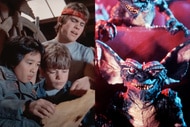Horror short 'Stucco' directors explain how to make out with a wall — and land A-list cameos

If your house is spewing forth hair, slime, loose teeth, or some combination of all three, you may want to call an exorcist... or the writing/directing duo Janina Gavankar and Russo Schelling. Yesterday, SYFY WIRE exclusively debuted the pair's new short horror film, Stucco, a uniquely cinematic parable about the monstrous nature of depression and anxiety.
The idea for the project was derived from real-life experiences with mental illness, but the decision to express that via the horror route came about half a decade ago.
***SPOILER WARNING: The following contains certain plot spoilers for Stucco!***
"Horror is just a genre that I have loved and kind of brought Janina on. About five years ago, I was like, 'You have no idea how horror movies can be' and we sat down and we watched all these incredible horror films," Schelling told SYFY WIRE during a recent interview.
"He sat down me down and sort of gave me my Neo 'I know kung-fu' [moment], except with horror movies in our first years of knowing each other," Gavankar (The Way Back), who stars in Stucco as a woman completely afraid to leave the comfort of her new home, explains. She slowly begins to lose her grip on reality after discovering a strange hollow space behind her wall.
"It slowly became apparent that our first thing would be horror and when I was writing this thing, we didn't plan on even making it," Schelling continues. "It was more a therapy piece than anything and then Janina was like, 'We have to make this movie. It's too specific.'"
When it came to horror influences, the pair (who co-wrote and co-directed the picture) looked to two claustrophobic classics of the 1960s: Repulsion (1965) and Rosemary's Baby (1968).
"I'd say [we were going for] that 'apartment horror' vibe," admits Schelling, who also cited 1981's Possession (which starred Sam Neill) as an influence on Stucco. "It is a f***ing crazy movie. It's so much fun, though."
While dealing with her current situation, the protagonist participates in Skype sessions with her therapist, who is played by none other than Will & Grace vet Debra Messing. The high-profile cameo partly came about from Russo's time spent as a production assistant on The Mysteries of Laura, which ran for two seasons on NBC with Messing in the titular role.
"We actually Skyped her in for real," Gavankar explains. "We shot the screen, so that is a live performance and she did it from New York. She's such a professional, she just was so prepared, brought a ton of life [to it]. We basically had no notes for her."
"She's such a pro, she already knows what you're talking about. Even before you say anything, she's like, 'I got it,'" Schelling says.
Messing wasn't the only pro attached to Stucco. That tongue scene? The prop was created by Frank Ippolito, a practical effects wizard whose onscreen credits include major franchises such as Star Wars, Pirates of the Caribbean, and The Chronicles of Riddick.
"Frank is truly one of the best in the business," Gavankar says. "We called him and sent him the script. He was like, 'I'm gonna make that tongue.' I, like an idiot, said, 'No, no. I'll find someone who I feel comfortable making out with.' And he sternly told me, 'Walls are thick, tongues are short' ... Frank hand-crafted and hand-painted the tongue, put four pulleys in the back of it, and had two puppeteers behind that wall."
"It was real old school practical effects," Schelling explains. "People who work in props and special effects don't get to puppeteer that much anymore, so when they get a chance to puppeteer, they take it super seriously. You see them practicing for hours ... By the time you do the scene, you get something like you see [in our film]. It looks unnatural, but it still kind of moves in the way your tongue moves. It was just super fun to do and a dream to work with practical effects and puppeteering."
And when it came to the ending sequence, Ippolito and his team at Thingergy stepped in again, this time to create the body throne, which wasn't in the script from the beginning.
"The original ending was very different. It wasn't as fight-for-your-life; it was kind of esoteric and a little vague," Schelling says, explaining that he had a major epiphany while walking the streets of New York and listening to music by the post-hardcore band La Dispute.
"They have this song, 'The Last Lost Continent.' They talk about this thing eating at somebody's brain, the vocalist kills it, and then makes a throne out of the body parts," he explains. "It was just so inspiring, I was like, 'This is what this thing needs.'"
"It took us a little bit of time to figure out what was on the other side of the wall. Enter La Dispute," Gavankar continues. "How rare is it for a band to give you the literal ending to your film? And then we became friends with them and they allowed us to use one of their songs in the trailer."
So, what does the hole in the wall represent thematically? Is it the main character's agoraphobia manifested in a physical form? Is it a representation of the fragile mental state of someone dealing with depression? Don't expect a definitive answer (and rightly so) from the filmmakers.
"I don't expect a painter to stand by their painting and say, 'This is what I meant by this.' Whatever your interpretation is, that's what it is," Schelling says. "If we explain our movie down to the detail, then we're robbing people of their creativity and their own interpretation."
"That's the thing and again, that's what goes back to horror," Gavankar adds. "It's this weird magic trick, where the more specific you allow yourself to get, the more universal it somehow becomes."
Stucco goes live on the ALTER YouTube page on Wednesday, March 11.































